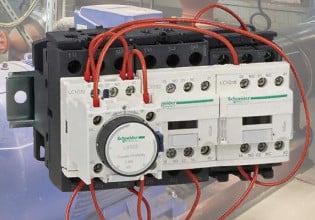Object Detection With a Lower Investment: Balluff’s New BGL Fork Sensor
The new BGL fork sensor series by Balluff eases the entry into automated object detection. The cost-effective sensors are easy to install and configure for assembly line and work cell automation.
Balluff has announced the availability of a new series of entry-level fork sensors. The BGL fork sensor uses red light to detect the presence of objects, such as items moving down an assembly line.
Fork Sensors
Fork sensors fall under the optical proximity sensor category, looking for objects by detecting the moment when a beam of light is broken. The unusual name comes from the shape of the device: two prongs, one with a light source and one with a light detector. As an object passes between the prongs, the light beam is broken, and the detector indicates that an object is present.
These sensors act much like a sending/receiving pair, which is one of the oldest forms of light sensing, but they are integrated into a single package. A much smaller version exists on printed circuit boards as the detector for encoder disks.
Object detection is used for nearly every kind of industrial process. While no information about the actual object (composition, dimensions, or other quality control items) can be directly measured, the fork sensor can ensure proper placement of objects. For example, it can be used to ensure a large item has passed into the work area of a robot, where the robot handles the finer alignment or assembly steps. Fork sensors can be used to count objects, where either the broken beams or the continuous beams are counted, depending on the sampling rate.

Two BGL fork sensor examples. the right one is perpendicular to the line, but the left one is not. Both are valid configurations. Image used courtesy of Balluff
The Balluff BGL Fork Sensor
The BGL transmits red light, which is collected at the opposite end of the fork. While many systems use other wavelengths, each providing unique advantages, the red light makes configuration, setup, and testing much easier. A technician can simply ensure that the red light is being deflected by passing objects.
Besides the simplicity, the wide forks are available in three sizes: 30, 50, and 80 mm. They do not have to be placed perpendicular to the objects they are trying to detect, opening up many physical configuration possibilities. Three sizes and an infinite number of angles mean they can be placed on virtually any production line. All sizes provide a discrete PNP/NPN output signal, either NO or NC, depending on the signal polarity chosen.
This entry-level product is cost-effective, but does not sacrifice capability. Its aluminum housing is sealed and rated to IP67 (protects against dust and moisture exposure), meaning it is suitable for rugged, industrial use. It is also capable of detecting objects in a variety of lighting conditions, a common challenge for most red light sensors.
The ease of installation makes these sensors attractive as well. Because the transmitter and the detector are in the same housing, they will always be in alignment with each other and require minimal cabling.
Potential Industrial Uses
Optimized for cost effectiveness and ease of use, the BGL fork sensor will see many uses in small automation systems. It is a good first choice for small manufacturing outfits who do not have a lot of capital to “play” with automation, but recognize the benefit of automation. It is also a good choice for organizations that are in the process of scaling up production or want to build a pilot production manufacturing line, as the sensor is versatile in its mounting arrangements and simplicity of design.






